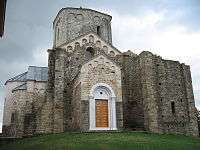Đurđevi stupovi
| Đurđevi stupovi Ђурђеви cтупови | |
|---|---|
 | |
| Basic information | |
| Location | Ras, (Novi Pazar) |
| Affiliation | Serbian Orthodox Church |
| Architectural description | |
| Architect(s) | Stefan Nemanja |
| Architectural type | Byzantine |
| Architectural style | Byzantine |
| Completed | 1166 |
| Specifications | |
| Dome(s) | 1 |
| Materials | Stone |
| Official name: Stari Ras | |
| Type | Cultural |
| Criteria | i, iii |
| Designated | 1979 (3rd) |
| Reference no. | 96 |
| Region | Europe and North America |
Đurđevi stupovi (Serbian Cyrillic: Ђурђеви cтупови, "Tracts of [St.] George") is a Serbian Orthodox monastery located in the vicinity of today's city of Novi Pazar, in the Raška region of Serbia.
The monastery is located near Novi Pazar, on the top of a prominent elevation covered with woods. It was erected in ca. 1170 as an endowment of Grand Prince Stefan Nemanja, dedicated to St. George; it is known as the "Tracts of St. George", often incorrectly as "Pillars of St. George". The monastery is exceptional not only for its position and significance it had according to medieval chronicles and manuscripts, but also for its particular architecture. It was named after the church dedicated to St George and its two former bell towers, two high towers – pillars (old Slavic language- stolp, stub). Namely, according to Stefan the First-Crowned, Nemanja had built this church to commemorate his gratitude to St. George for saving him from dungeons-caves where he was put by his brothers.
The monastery complex consisted of church of Saint George, dining-room, refectory, water tanks and walls around entry tower. The architecture of the Saint George Pillars Monastery is very characteristic representing unique synthesis of two medieval construction concepts, Byzantine in the East and Roman in the West. Monastery is a building with a set of architectural and construction innovation in that period, among which there are two remarkable towers, lateral vestibules, cupola with elliptic basis, irregular shape of altar area, as well as specific arrangement of the central dome space of the church. Single-aisle temple with the altar consisting of three apses, naos and narthex, in its external appearance reflects the spirit of Roman construction. The combination of Byzantine spatial arrangement and Roman architecture resulted in original symbiosis that has been the ground for special architectural style. The entry tower, after the additional construction of apses in the east side in 1282-83, had been turned into chapel that king Dragutin designed for his tomb. The inside of the chapel is covered by frescos with historical content and portraits of the Nemanjics. The frescoes of this Monastery, rendered in the best tradition of the Comnenus style and skillfully adapted to the architecture of the temple, which is especially pronounced in the all-embracing cupola, have particular value. The most impressive is the picture of Saint George on the horse, which is above the main entrance in the church. Beside this very distinctive one are frescoes of four Serbian state councils where important decisions related to the Serbian history were made. A small building has been erected in front of the monastery and it is used as a museum for the protection and exhibition of the most important fragments from church and other structures, where some have been fully composed and reconstructed. As a part of the entity Stari Ras with Sopocani, Saint George Pillars Monastery has been on the list of UNESCO World Heritage Sites since 1979 and it is on the Transromanica Route.
Burials

See also
| Wikimedia Commons has media related to Đurđevi stupovi. |
Coordinates: 43°09′56″N 20°29′48″E / 43.16556°N 20.49667°E

